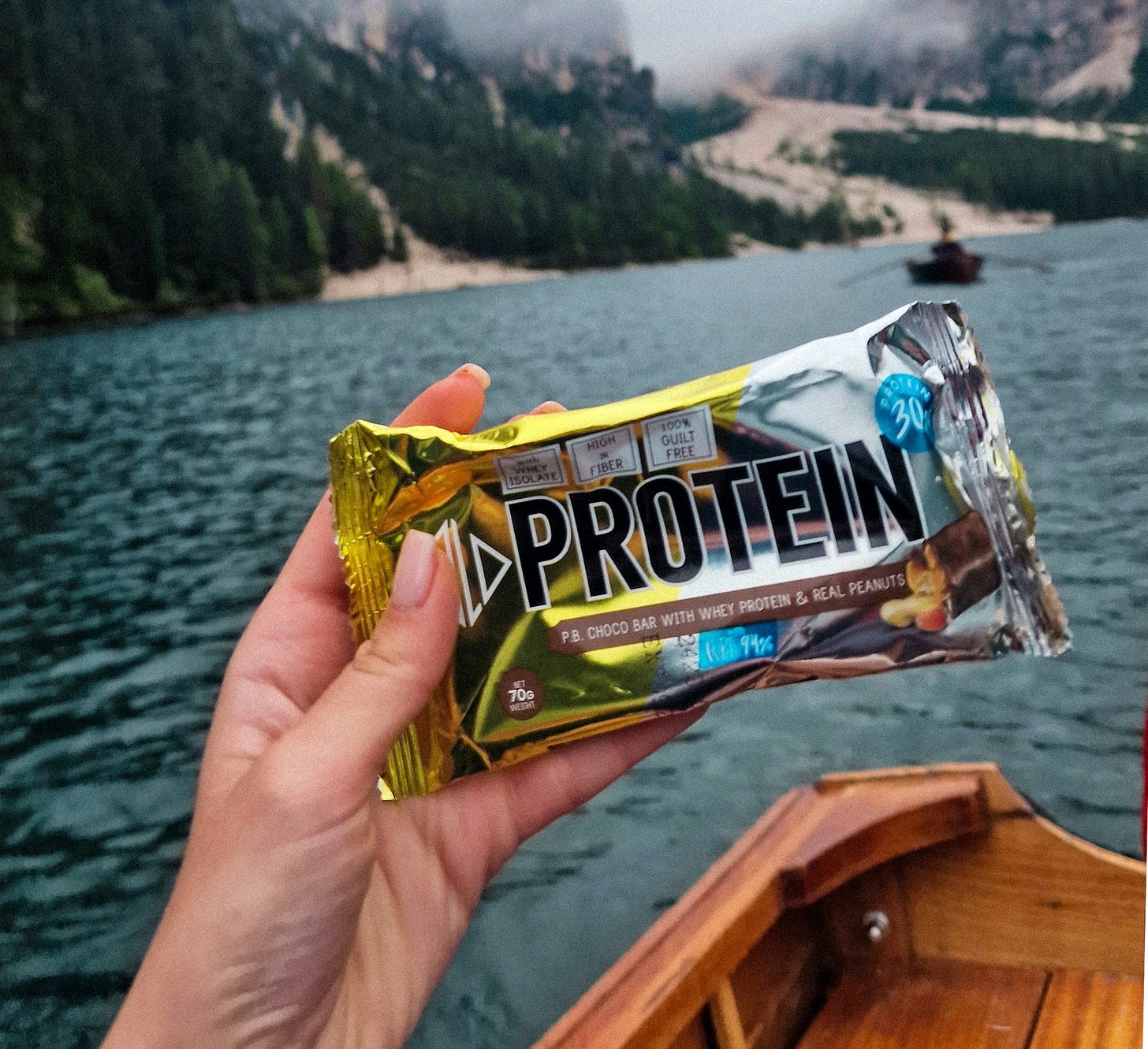If you've been following fitness and nutrition trends lately, you've probably heard: "One gram of protein per pound of body weight." For a 180-pound person, that's 180 grams daily—often requiring protein shakes, bars, and constant meal planning just to hit the number.
But what if this protein obsession is actually working against us?
The Problem with Protein Maximalism
Mark Sisson, the founder of Primal Kitchen and a 40-year veteran in the health space, recently shared some eye-opening perspectives that challenge our current protein paradigm. After decades of research and personal experimentation, Sisson has moved away from the "more is better" mentality that dominates fitness culture.
At 172 pounds, the current recommendations would have Sisson consuming 172 grams of protein daily. His reality? He never hits that number and feels uncomfortable when he tries.
The Minimum Effective Dose Approach
Instead of chasing maximums, Sisson advocates for finding your minimum effective dose—the least amount of protein needed to maintain health, energy, and muscle mass without feeling hungry.
His recommendation is surprisingly simple: 120 grams per day for men (+/- 20 grams) and significantly less for woman.
Your Body Doesn't Need Protein Every 3 Hours
One of the biggest myths in fitness is that you need to spread protein evenly throughout the day or risk losing muscle. Sisson debunks this completely:
"We don't need to be getting 30 grams every meal, four meals a day. If on average over the past four days I've consumed 100-120 grams of protein on a daily basis, I'm good. If one day was 80 and one day was 140, it doesn't matter."
The reason? Your body has protein reserves. Muscle tissue acts as a "protein sink," storing amino acids for when they're needed. Your liver also maintains protein reserves. This means you don't need to stress about perfect timing or distribution.
The Metabolic Cost of Excess Protein
When you consume more protein than your body needs for construction and repair, it doesn't just disappear—it gets converted to glucose through a process called gluconeogenesis1. And this process is metabolically expensive.
Think of gluconeogenesis as paying a hefty tax on your protein:
High Energy Investment: Converting protein to glucose requires significant ATP (cellular energy)
Multi-Step Process: Unlike burning glucose or fat directly, this involves complex enzymatic reactions
25-30% Energy Loss: You lose up to 30% of the protein's energy value through conversion
Double Taxation: You pay the normal thermic effect of protein (20-30%) PLUS the conversion cost
Why This Matters
When someone eats 200 grams of protein daily and gets leaner, they're not necessarily building more muscle. Instead, their body is:
Using the first 100-120g for construction and repair
Converting the excess 80-100g through expensive gluconeogenesis
Burning more calories processing the protein than the protein provides
Creating unnecessary metabolic stress
You're not going to build more muscle just because you're taking in more protein.
The Science Behind Protein Diminishing Returns
A comprehensive 2020 meta-analysis published in Nutrition Reviews2 examined 105 studies involving over 5,400 participants found that protein benefits for lean body mass rapidly diminish after 1.3 grams per kilogram of body weight per day. This wasn't a small effect—it was dramatic. Below the 1.3g/kg threshold, each 0.1g/kg increase in protein yielded substantial muscle gains (0.39 kg increase in lean body mass). But above 1.3g/kg? The benefits dropped by more than two-thirds to just 0.12 kg of lean body mass per 0.1g/kg increase.
What this means in practical terms:
For a 150-pound person: Optimal intake is around 88 grams of protein daily
For a 180-pound person: About 106 grams daily
For a 200-pound person: Roughly 118 grams daily
These numbers are significantly lower than the popular "1 gram per pound" recommendation that would have these same people consuming 150-200 grams daily—essentially paying a huge metabolic tax for minimal additional benefit.
Perhaps most importantly, the researchers found this diminishing returns pattern held true whether people were doing resistance training or not. While exercise helped maintain some efficiency at higher protein intakes, it didn't eliminate the fundamental biological ceiling for protein utilization.
The implications are clear: our bodies have evolved sophisticated mechanisms for protein management, but they have limits. Push beyond those limits, and you're not building more muscle—you're just creating expensive urine and forcing your liver to work overtime converting excess protein to glucose.
Why We Actually Need External Protein: A Biological Reality
To understand why the minimum effective dose approach makes sense, it's crucial to grasp why we need external protein in the first place.
The human body cannot produce nine essential amino acids: histidine, isoleucine, leucine, lysine, methionine, phenylalanine, threonine, tryptophan, and valine. The body cannot make essential amino acids as we lack the metabolic enzymes and pathways. These nine amino acids must be obtained from the diet.
This isn't a design flaw—it's actually an evolutionary trade-off: Humans evolved to lose the complex metabolic pathways needed to synthesize essential amino acids because it was energetically advantageous to obtain them from food sources. Freeing up energy for other survival advantages.
The question isn't whether we need dietary protein—it's how much we actually need vs. how much we've been told to consume.
The Raw Food Perspective: Even Less Can Work
The conversation about minimal protein intake becomes even more interesting when we look at advocates of raw food diets like Natalia Rose, who take protein minimalism to an extreme that would shock most fitness enthusiasts.
But how is it possible to feel so much energy without eating protein, in the traditional sense, at every meal? Rose is quoted as saying:
"Just as a horse will manufacture all the protein it needs for its strong musculature from greens, so too will a human."
What’s My Minimum Effective Dose?
Green or Red juice in the morning, fruit/green smoothies throughout the day. I add spirulina, bee pollen, or pumpkin seeds to boost nutritional value) and in the evening, a cooked meal with a leafy green salad. When I do include more concentrated protein sources, I'm focusing on options like:
Fish or other seafood (but not more than once a day)
Kelp noodles, Seaweed, Dulse - they contain all essential amino acids. (Marine proteins are often more easily absorbed than land-based plant proteins)
Tahini or nut-based dressing (ever tried kale massaged with tahini and lime?)
Small quantities of goat cheese
My meals definitely aren't balanced in the traditional sense that would make a Zone diet devotee from the '90s proud. Some days I’ll get 60g of protein, others 140g. Trust your protein reserves to handle fluctuations.
Bottom Line
After 40 years in the health space, Mark Sisson's message is clear: How you feel is more important than hitting arbitrary numbers.
"At the end of the day, you can have all the right scores and all the right blood work. And if you feel like crap, none of it matters."
The protein obsession has led us away from intuitive eating and toward complicated tracking, expensive supplements, and metabolic inefficiency. Perhaps it's time to step back, focus on adequate rather than excessive intake, and let our bodies do what they've evolved to do over millions of years.
Your minimum effective dose of protein might be far lower than you think—and that's not just okay, it's optimal.
Sources:
https://ajcn.nutrition.org/article/S0002-9165(23)26539-9/pdf
https://academic.oup.com/nutritionreviews/article/79/1/66/5936522?login=false







I love my protein!